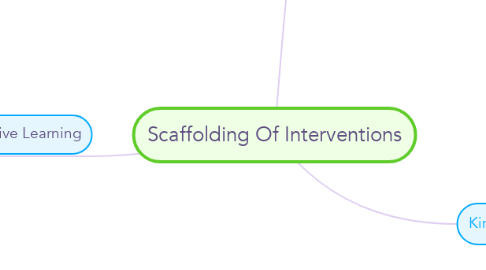
1. Cognitive Learning
1.1. Piaget
1.1.1. Main Ideas
1.1.1.1. How Development Occurs
1.1.1.1.1. Schemes
1.1.1.1.2. Adaptation
1.1.1.1.3. Assimilation
1.1.1.1.4. Accomadation
1.1.1.1.5. Equilibration
1.1.1.1.6. Constructivism
1.1.1.2. Stages of Cognitive Development
1.1.1.2.1. Sensorimotor Birth to 2 yrs.
1.1.1.2.2. Preoperational 2 to 7 yrs.
1.1.1.2.3. Concrete Operational 7 to 11 yrs.
1.1.1.2.4. Formal Operational 11 yrs. to adulthood
1.1.2. Criticism
1.1.2.1. Tasks can be taught to children at earlier developmental stages.
1.1.2.2. Children's skills can develop in different ways on different tasks.
1.1.2.3. Experience can have an influence on pace development.
1.1.3. Educational Implication of Piaget's Theory
1.1.3.1. Developmentally Appropriate Education
1.2. Vygotsky
1.2.1. 2 Key Ideas
1.2.1.1. Intellectual development can be understood only in terms of the historical and cultural contexts children experience.
1.2.1.2. Development depends on the sign systems that individuals grow up with: the symbols that cultures create to help people think, communicate, and solve problems.
1.2.2. How Development Occurs
1.2.2.1. Self-regulation
1.2.2.2. Private Speech
1.2.2.3. Zone of Proximal Development
1.2.2.4. Scaffolding
1.2.2.5. Cooperative Learning
2. scaffolding characteristics
2.1. clear directions
2.2. clear purpose
2.3. keeps students on task
2.4. assessment to clarify expectations
2.5. teacher responsibility
3. Kindergarten
3.1. Reading
3.1.1. Reading Development
3.1.1.1. Phonemic Awareness
3.1.1.2. Phonological Awareness
3.1.1.3. Reading Comprehension
3.1.2. Techniques
3.1.2.1. Read Short Stories
3.1.2.2. Books with large print
3.1.2.3. Few words focus on sight words
3.1.2.4. Stories with patterns/Rhymes
3.1.2.5. Pictures give clues
3.1.2.6. Highly Predictable Storyline
3.1.3. Interventions
3.1.3.1. RTI
3.1.3.2. Tutoring
3.1.3.3. Reading Programs
3.1.3.3.1. My Skills Tutor
3.1.3.3.2. Starfall
3.1.3.4. Reading Recovery Program
3.1.3.5. Curriculum Interventions
3.2. Writing
3.2.1. Writing Development
3.2.1.1. Scribbling
3.2.1.2. Letter-like Symbols
3.2.1.3. Strings of Letters
3.2.1.4. Beginning Sounds
3.2.1.5. Consonants Represent Wrods
3.2.1.6. Initial, Medial, Final Sounds
3.2.1.7. Transitional
3.2.2. Techniques
3.2.2.1. Invented Spelling
3.2.2.2. learning to spell simple words CVC
3.2.2.3. Pencil grip
3.2.2.4. proper letter formation
3.2.2.5. strengthen fine motor skills
3.2.2.6. copying words/sentences
3.2.2.7. Shared writing activities
3.2.3. Interventions
3.2.3.1. RTI
3.2.3.2. Tutoring
3.2.3.3. Handwriting Programs
3.2.3.3.1. Handwriting Without Tears
3.2.3.3.2. The Handwriting Clinic
3.2.3.4. Reading Recovery Program
3.2.3.5. Curriculum Interventions
3.3. Vocabulary
3.3.1. Vocabulary Development
3.3.1.1. Knows between 2,100 - 2,600 vocabulary words
3.3.1.2. Receptive Vocabulary of 20,000 - 24,000
3.3.2. Techniques
3.3.2.1. Print Rich Classroom
3.3.2.2. sight words
3.3.2.3. Books on CD
3.3.2.4. Word Meaning
3.3.2.5. Word Walls
3.3.3. Interventions
3.3.3.1. RTI
3.3.3.2. Tutoring
3.3.3.3. Vocabulary Programs
3.3.3.3.1. My Skills Tutor
3.3.3.3.2. Starfall
3.3.3.4. Reading Recovery Program
3.3.3.5. Curriculum Interventions
